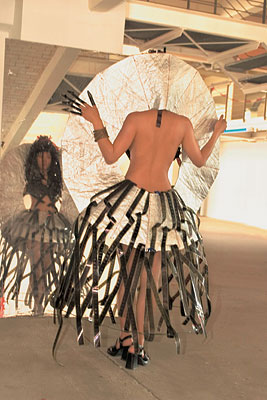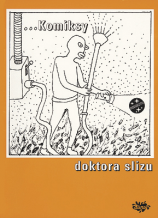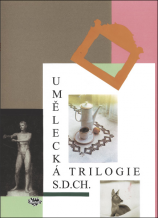| Umělec 2005/3 >> Art & Garbage or Recycled Esthetics in Post-war Central Europe (1917-2005) | Просмотр всех номеров | ||||||||||||
|
|||||||||||||
Art & Garbage or Recycled Esthetics in Post-war Central Europe (1917-2005)Umělec 2005/301.03.2005 Tony Ozuna | waste | en cs de es |
|||||||||||||
|
At the end of the disastrously bloody massacre known as World War I, the disillusioned ex-solider Kurt Schwitters (1887-1948) became an artist, first joining the Dadaists but ultimately he staked a claim in art that was not solely a part of that group. The German Dadaists were attracted to and concentrated in Berlin, but Schwitters was a good distance from there, firmly rooted in his “provincial” home town, Hannover. The Dadaists were anti-art, yet artists–controversial to say the least. Schwitters was less political. Dressed like a businessman rather than an anarchist, he followed his own, more personal though still risky path. After the war Schwitters roamed the streets, picking through the rubble in the bombed-out sections of his city. Like a homeless scavenger, he would pick through the huge piles of bricks and chunks of concrete, as well as garbage in alleys, in trash cans, in the gutter, and with his findings, he would make his art. He habitually collected “disheveled remnants, discarded scraps, things so decidedly second-hand and unserviceable that they are routinely subsumed under the generic label of ‘garbage.’”
Schwitters once talked about his art method as a campaign to salvage the debris and fight the chaos left behind, by the war. “Out of frugality, I drew on what came to hand, for we were a poverty-stricken country. One can still cry out by way of bits of garbage, and that is what I did, by glueing or nailing them together. This I called Merz…. Nothing was left intact anyway, and the thing was to build something new out of the broken pieces.” Schwitters divided his art into three main categories: Merzzeichnung (scraps of paper to make collage), Merzbild (scraps of harder materials to build assemblages), and Merzbau or The Cathedral of Erotic Misery, his life work–a sculptural, architectural project built inside his home in Hannover. The raw material of Kurt Schwitters’ art for all three of his categories was, thus, garbage. For collage, this included scraps like newspaper clippings, chocolate wrappers, tram and theater tickets, pictures from magazines, etc. from his own trash can and off the street. For assemblage, this included rusty nails, “sections of plywood, chicken wire, umbrella spokes, coins, buttons, broken hinges, broken plates, shoe-leather, fragments of cloth, shards of metal.” For Merzbau this incorporated all life material, and was a work in progress since its beginning in 1923, up till the time that Schwitters was forced to emigrate from Nazi Germany in 1937. One of the most courageous, unusual works of art in Europe in the 20th century, Merzbau was totally destroyed in 1943 by Allied bombing. Schwitters’ significant contribution was the incorporation of garbage into his work, or rather the transformation of garbage into art. Though oftentimes rough around the edges, his collages, assemblages, and Merzbau created an aesthetic second a life for discarded items—his work is housed now in museums or personal collections, with the exception of the destroyed Merzbau in Hannover, and his second attempt of Merzbau, in Norway, near Oslo, where he lived briefly after fleeing Germany. Merzbau 2 burned to the ground in 1951, eleven years after Schwitters had already fled Norway because of the Nazi occupation in 1940. The last segment of Schwitters’ life is portrayed in the engaging opera Man and Boy: Dada, composed by Michael Nyman and libretto by Michael Hastings. At this point in his life, in 1945, Schwitters’ is a refugee in London, on the verge of homelessness though still obsessed with collecting trash– and in this case, he is most interested in London’s rarest, used tram tickets. In Man and Boy: Dada, Schwitters meets and befriends a young, fatherless boy as they jostle for coveted used-tickets. Their friendship grows despite their sharply differing purposes for collecting. Their mutual affection for debris, however, is stronger than their personal differences. Man and Boy: Dada was first performed in spring 2004, by the Badisches Staats-theater in Karlsruhe, Germany. It is being performed throughout 2005, by the exceptional Agon Orchestra in Prague’s National Theater. Like Schwitters’ urban trash hunting in Germany, in 1992-93 the Japanese artist, Naoaki Yamamoto spent much of his time roaming the most destroyed neighborhoods of Prague in search of debris. However, Yamamoto was more discerning than Schwitters in his rummaging; he collected only discarded doors– of wood or metal, it didn’t matter. Originally, he came to Prague for one year to study the technique of Bohemian Gothic painting, and so like Master Theodoris, he joked, he had to learn how to paint on wood. Yamamoto was already painting figures and doors in Japan, but he had never painted on wood. In Prague, doors became an obsession. Perturbed by the uniform, modern apartment (prefab) doors, he even had claustrophobic nightmares about them. Yamamoto said, “It is horrible to be surrounded by thousands of identical doors that click firmly into place!” The uniform Czech doors were the antithesis of the light sliding door of a Japanese home, and they left him utterly disturbed when he came across them. On the other hand, he was relieved from this terror by the beauty of old doors on the streets everywhere in Prague. Each was different, decorated, aged, dirty with usage, and he was impressed by their heaviness. He even furtively painted on some doors in public spaces, such as Republic Square, which he crossed daily. During his stay in Prague, Yamamoto collected as many abandoned doors as he could, and ten years ago these were found in abundance in vacant buildings or in piles of garbage in courtyards. After getting them to his studio, he removed the paint from these doors by flame, so he could paint or draw on the natural wood with natural materials. Yamamoto broke from his traditional Japanese painting style Nihonga for his project in Prague. (The traditional background material for Nihonga is silk or soft and highly absorbent, stretched hand-made paper called washi.) Using the wooden Czech doors as his background, instead, he applied basic natural materials like, black ink, white chalk, mineral pigments from pulverized stones and ores, powdered or plate gold and silver, crushed shells, sand, clay, glue and food crumbs. He even discovered one original pigment in Prague: The Bohemian Green Earth, and he also used Czech sand and clay. He also left some of the original paint on the doors as a background, for the “beauty of its texture.” Over his expressive strokes of color on wood, Yamamoto left barely visible shadows of figures, of either himself or his father in Japan (who was dying while he was in Prague). His selected work from this project, exhibited in 1993 (The Door is Ajar, Galerie Art Forum in Karlovy Vary, and Naprstkovo Museum, Prague), was a surprise to Czechs because the artist had found beauty in piles of trash abound in the city, and so inspired by this, his doors became a metaphor for his own Czech experience, which was fraught with misunderstanding and lack of communication since he spoke no Czech and his English was unintelligible to most Czechs because of his strong Japanese accent. Works by Kurt Schwitters and Naoaki Yamamoto show earnest attempts to transform discarded materials into art. Mike Kelly’s humorous installations of stuffed animals, for instance More Love Hours Than Can Ever Be Repaid, 1997, (stuffed fabric toys and afghans on canvas) are a popular, conceptual counterpart, but his series lacks the industrious determination (the hands-on effort) to transform matter like Schwitters and Yamamoto accomplished by digging through trash in Central Europe. A recent exhibition in a former bread factory in East Berlin, the 3rd annual RestCycling Art Festival, Sept. 4th – 25th, is founded on a similar tone. The festival’s motto by German writer Aleida Assmann is this: “When artists integrate refuse–that is, whatever has been excluded from the economy–into their works and installations they achieve two things: they construct a new economy, and they also force the viewer to cross over the external limitations of his symbolic, sensory world, so becoming aware of the system “culture” with its mechanisms of devaluation and exclusion.” The RestCycling festival included established artists and “art amateurs” and incorporated improvisational sculpture and installation, new media and photography, design and fashion, painting and graphic arts, performance and music. With its concern to help raise social awareness, it also included talks and discussions on issues of environmentalism, consumerism and recycling. There were experimental and documentary works from international video artists, workshops, kid’s educational programs, theater and performances, concerts, DJs, and a fashion show. The festival’s theme was “100% cre-Active,” and the artists who “cre-activated” some of the most interesting work included Magdalena Clerc’s installation Madame von Lichtenauer, an artistic fashion statement on camouflage and impersonation, Click Here, by Raphael Isdant of the Paris-based Darwah Group, is a clever sculpture of computer mice, cables, polyurethane foam and white acrylic paint, and Miss Lata’s unconventional fashion wear, including a woman’s tank-top made from a back-pack, a skirt made of plastic vacuum cleaner parts, and accessories, including a handbag created from a Lowenbrau mini-beer barrel. Miss Lata is a Berlin-based performance artist and designer, originally from Spain, and also co-curator of the RestCycling festival. She says the idea of such a group of artists– painters, designers, sculptors, video-artists, stylists–working live (in process) in front of a public exists from 13 year-old festivals like “La Braderie de l’Art” in Roubaix (France), and also in DRAP ART in Barcelona in 96 and 97. Miss Lata has been recycling found material into art for fifteen years. She says that she started to “create her investigation with everything possible–found materials–in Berlin.” Her favorite material is metal, specifically cans. She creates “collections” every year, and her work is shown in fashion shows, with models, choreography and music. In her recent essay, Zen and the Art of Trashpicking, Beth Zonderman writes, “Scavenging is an activity like anything else, which when done with inspiration can be raised to an art; and when done with discipline, consciousness and devotion, becomes spiritual endeavor.” Though Zonderman’s essay is paying tribute specifically to František Skála, the scavenger and artist extraordinaire of the Czech Republic nowadays, her essay refers to all artists with this obsession to pick through trash. Zonderman, who is an American artist and graphic designer that lived in Prague in the early to mid-90s, continues: “It is more than the simple ‘one’s trash is another’s treasure’, but a process of applied karma, keeping things in motion and accepting and appreciating the bounty of the universe. The most talented (“lucky“) of dumpster divers, second-hand shoppers and pilferers recognize their acquisitions as gifts rather than quarry. The devoted finder-of-things, like any artist, must have in their portfolio some of the following traits: perseverance and training, intuition (good stuff radar), openness of mind to see that which is invisible to others, ability to see beauty and wisdom in unexpected places and/or God-given talent – i.e.: be in excellent graces with the angels who leave stuff for people to find.” Zonderman describes Skála’s work best: “His skill is nearly Faustian, in that it walks the fine line between holy and unholy meddling… If a work of art is equivalent to an artificially made object with a life of its own, Skála makes Golems not out of inert matter but out of living material (not literally, but possessing a strong identity and personal history). Any artist using found materials seeks to do this, but Skála at his best transforms identities of his ingredients in the manner of an alchemist or sorcerer.” That is quite a compliment, but well justified. In this realm of transmutation, František Skála is an undisputed zen master in the wild kingdom of art & garbage. At the end of Nyman’s Man and Boy: Dada, Schwitters (the refugee who is always still in a suit), tells the boy why they are so different in character: “You love order, and I love the beauty of chaos.” Schwitters is also explaining the meaning of Dada and his own artistic aesthetic to the boy, with this phrase. Skála, the scavenger, departs from Schwitters here: while he loves the beauty of chaos like Schwitters, Skála is rooted in and inspired by the hidden, mystical forests of Bohemia instead of war-torn urban battle-zones. Skála creates his best sculptures by simply succumbing to the random and chaotic beauty of nature.
01.03.2005
Рекомендуемые статьи
|
|||||||||||||
|
04.02.2020 10:17
Letošní 50. ročník Art Basel přilákal celkem 93 000 návštěvníků a sběratelů z 80 zemí světa. 290 prémiových galerií představilo umělecká díla od počátku 20. století až po současnost. Hlavní sektor přehlídky, tradičně v prvním patře výstavního prostoru, představil 232 předních galerií z celého světa nabízející umění nejvyšší kvality. Veletrh ukázal vzestupný trend prodeje prostřednictvím galerií jak soukromým sbírkám, tak i institucím. Kromě hlavního veletrhu stály za návštěvu i ty přidružené: Volta, Liste a Photo Basel, k tomu doprovodné programy a výstavy v místních institucích, které kvalitou daleko přesahují hranice města tj. Kunsthalle Basel, Kunstmuseum, Tinguely muzeum nebo Fondation Beyeler.
|


































 We Are Rising National Gallery For You! Go to Kyjov by Krásná Lípa no.37.
We Are Rising National Gallery For You! Go to Kyjov by Krásná Lípa no.37.
Комментарии
Статья не была прокомментированаДобавить новый комментарий